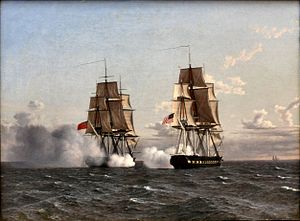| Capture of USS Chesapeake | |||||||
|---|---|---|---|---|---|---|---|
| Part of the War of 1812 | |||||||
 Battle between the English [sic] frigate Shannon and the American frigate Chesapeake, Christoffer Wilhelm Eckersberg (1836) | |||||||
| |||||||
| Belligerents | |||||||
|
|
| ||||||
| Commanders and leaders | |||||||
|
|
| ||||||
| Strength | |||||||
| 1 frigate | 1 frigate | ||||||
| Casualties and losses | |||||||
|
| ||||||
The capture of USS Chesapeake, also known as the Battle of Boston Harbor, was fought on 1 June 1813, between the Royal Navy frigate HMS Shannon and the United States Navy frigate USS Chesapeake, as part of the War of 1812 between the United States and the United Kingdom. The Chesapeake was captured in a brief but intense action in which 71 men were killed. This was the only frigate action of the war in which there was no preponderance of force on either side.
At Boston, Captain James Lawrence took command of Chesapeake on 20 May 1813, and on 1 June, put to sea to meet the waiting HMS Shannon, commanded by Captain Philip Broke. Broke had issued a written challenge to Chesapeake's commander, but Chesapeake had sailed before it was delivered.
Chesapeake suffered heavily in the exchange of gunfire, having her wheel and fore topsail halyard shot away, rendering her unmanoeuvrable. Lawrence himself was mortally wounded and was carried below. The American crew struggled to carry out their captain's last order, "Don't give up the ship!", with the British boarding party quickly overwhelming them. The battle was notably intense but of short duration, lasting ten to fifteen minutes, in which time 226 men were killed or wounded. Shannon's captain was severely injured in fighting on the forecastle, but survived his wounds.
Chesapeake and her crew were taken to Halifax, Nova Scotia, where the sailors were taken to prisoner-of-war camps; the ship was repaired and taken into service by the Royal Navy. She was sold at Portsmouth, England, in 1819 and broken up. Surviving timbers were used to build the nearby Chesapeake Mill in Wickham and can be seen and visited to this day. Shannon survived longer, being broken up in 1859.
- ^ Toll 2006, p. 415.
© MMXXIII Rich X Search. We shall prevail. All rights reserved. Rich X Search
